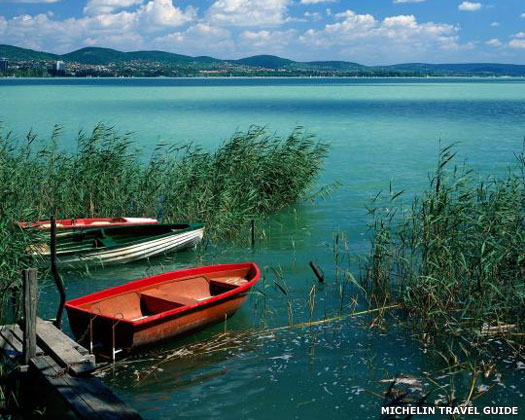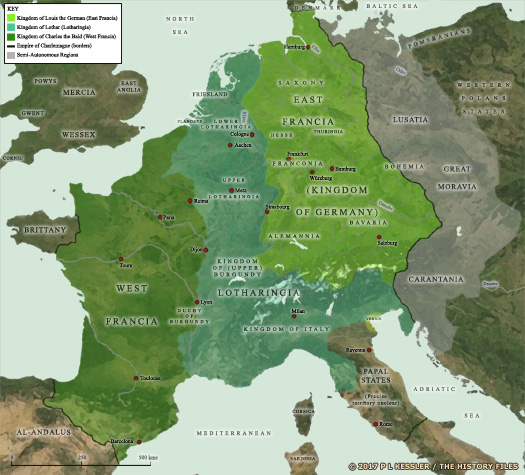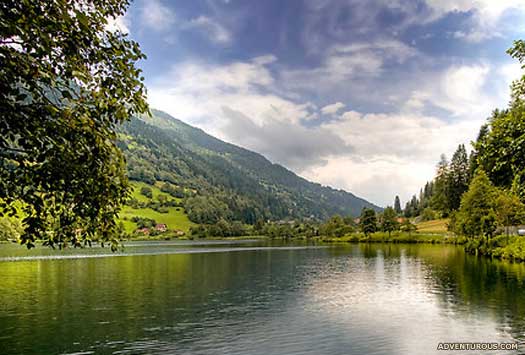 |
|
|
| (Information by Peter Kessler, with additional information from Empire of the Steppes - A History of Central Asia, René Grousset (1988), from The Oxford Handbook of Late Antiquity, Scott Fitzgerald Johnson (Ed, Oxford University Press, 2010), from Hungarians and Europe in the Early Middle Ages: An Introduction to Early Hungarian History, András Róna-Tas (Central European University Press, 1999), from The Barbarians: Warriors & Wars of the Dark Ages, Tim Newark (Blandford Press, 1985), from Avar Chronology Revisited, Peter Stadler, and from External Links: Turkic History, and For the Memory of the Avar Khagans, B Lukács, and The Slavs and the Avars, Omeljan Pritsak.) |
|
|
| 835 - 846 |
By this stage Avar leaders are effectively no more. Their role has been taken by Eastern Frankish lords who control the march, and by Prince Pribina, a Slav noble and adventurer who had been chased out of [Moravia](EasternBohemia.htm#Great Moravia) by Duke Mojmir I. He is granted the eastern section of Avar territory - in Lower Pannonia - as the Principality of Balaton or Lower Pannonia, with his headquarters near Lake Balaton on the River Zala (close to the modern village of Zalavár, in Zala County in Hungary, surrounded by forests and a swamp).  Lake Balaton today lies within the borders of Hungary, with landscapes, nature reserves, beaches, and folklore which make it focal point of the country's tourism trade Lake Balaton today lies within the borders of Hungary, with landscapes, nature reserves, beaches, and folklore which make it focal point of the country's tourism trade |
|
| 846 - 861 |
Dux Pribina |
Prince of Balaton and commander of eastern 'Avaria'. |
| 846 - 861 |
As dux of the eastern march and prince of Balaton, Pribina's main duty is to recruit the disparate groups of Slavs in the region and turn them into a border force which is loyal to the Eastern Franks. They serve to hem in the territorial ambitions both of [Great Moravia](EasternBohemia.htm#Great Moravia) and Bulgaria. Having himself been a victim of Moravia's ambitions, Pribina is only too happy to play a large role in Frankish campaigns against that state. During his reign many of his subjects are Christianised and many churches are built in the region. |
|
| 864 - 876 |
Comes Kocel |
Son. Prince of Balaton and commander of eastern 'Avaria'. |
| 864 - c.867 |
Kocel succeeds his father in Lower Pannonia as Comes de Sclauis, the count of the Slavs. By about 867, fearing Eastern Frankish influence and power, Rastislav of [Great Moravia](EasternBohemia.htm#Great Moravia) hosts representatives of Eastern Christianity.  King Louis 'the Pious' of the Frankish empire attempted to leave the empire intact for his eldest son, Lothar, but the others rebelled at the idea. The treaty of Verdun in AD 843 confirmed the official division of the empire between Charlemagne's three surviving grandsons (click or tap on map to view full sized) King Louis 'the Pious' of the Frankish empire attempted to leave the empire intact for his eldest son, Lothar, but the others rebelled at the idea. The treaty of Verdun in AD 843 confirmed the official division of the empire between Charlemagne's three surviving grandsons (click or tap on map to view full sized) |
|
| Cyril (or Constantine by birth) and Metodej (Methodius), two priors, begin the establishment of a church organisation for the Slavs, and create the Slavonic script (the Cyrillic alphabet which is still in use in Russia and Bulgaria, amongst others). On their subsequent journey to Rome they are hosted by Comes Kocel in Lower Pannonia. |
|
|
| 871 - 876 |
The combined Avar march territory is divided between [Carinthia](EasternCarinthia.htm#Duchy of Carinthia) and the 'Eastern March' - the latter being Lower Pannonia. Kocel has begun to resist Eastern Frankish control as he attempts to organised a Slavic diocese for the region. Following his death, Eastern Pannonia is given to Arnulf of Carinthia to command.  The modern southern Austrian region of Carinthia marked the upper edge of the Adriatic hinterland, relatively close to the short-lived principality of Balaton The modern southern Austrian region of Carinthia marked the upper edge of the Adriatic hinterland, relatively close to the short-lived principality of Balaton |
|
| The Magyars take control of territory to the west of the Danube in Dacia and Pannonia in 895-896, and with that they also gain the core of 'Avaria'. Written texts still mention the Avars for a time, but possibly already as an anachronism as they are now indisputably vassals of what will soon become the Hungarian kingdom. By around 960 western parts of Pannonia have been formed into a new march territory, that of [Austria](GermanyAustria.htm#Regensburg Margraves). |
|
|
 |
|
|

 Lake Balaton today lies within the borders of Hungary, with landscapes, nature reserves, beaches, and folklore which make it focal point of the country's tourism trade
Lake Balaton today lies within the borders of Hungary, with landscapes, nature reserves, beaches, and folklore which make it focal point of the country's tourism trade King Louis 'the Pious' of the Frankish empire attempted to leave the empire intact for his eldest son, Lothar, but the others rebelled at the idea. The treaty of Verdun in AD 843 confirmed the official division of the empire between Charlemagne's three surviving grandsons (click or tap on map to view full sized)
King Louis 'the Pious' of the Frankish empire attempted to leave the empire intact for his eldest son, Lothar, but the others rebelled at the idea. The treaty of Verdun in AD 843 confirmed the official division of the empire between Charlemagne's three surviving grandsons (click or tap on map to view full sized) The modern southern Austrian region of Carinthia marked the upper edge of the Adriatic hinterland, relatively close to the short-lived principality of Balaton
The modern southern Austrian region of Carinthia marked the upper edge of the Adriatic hinterland, relatively close to the short-lived principality of Balaton